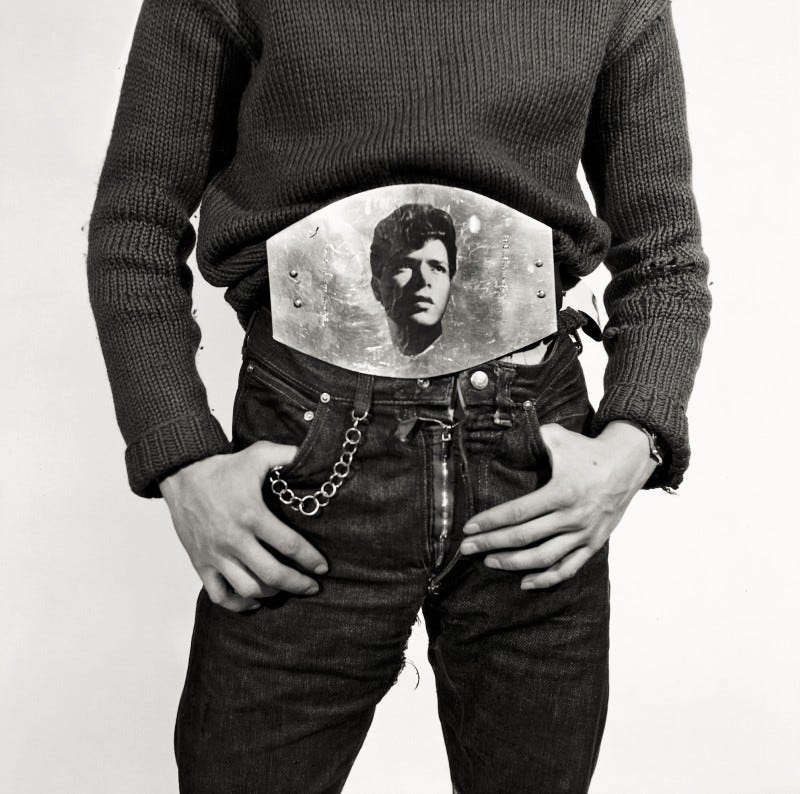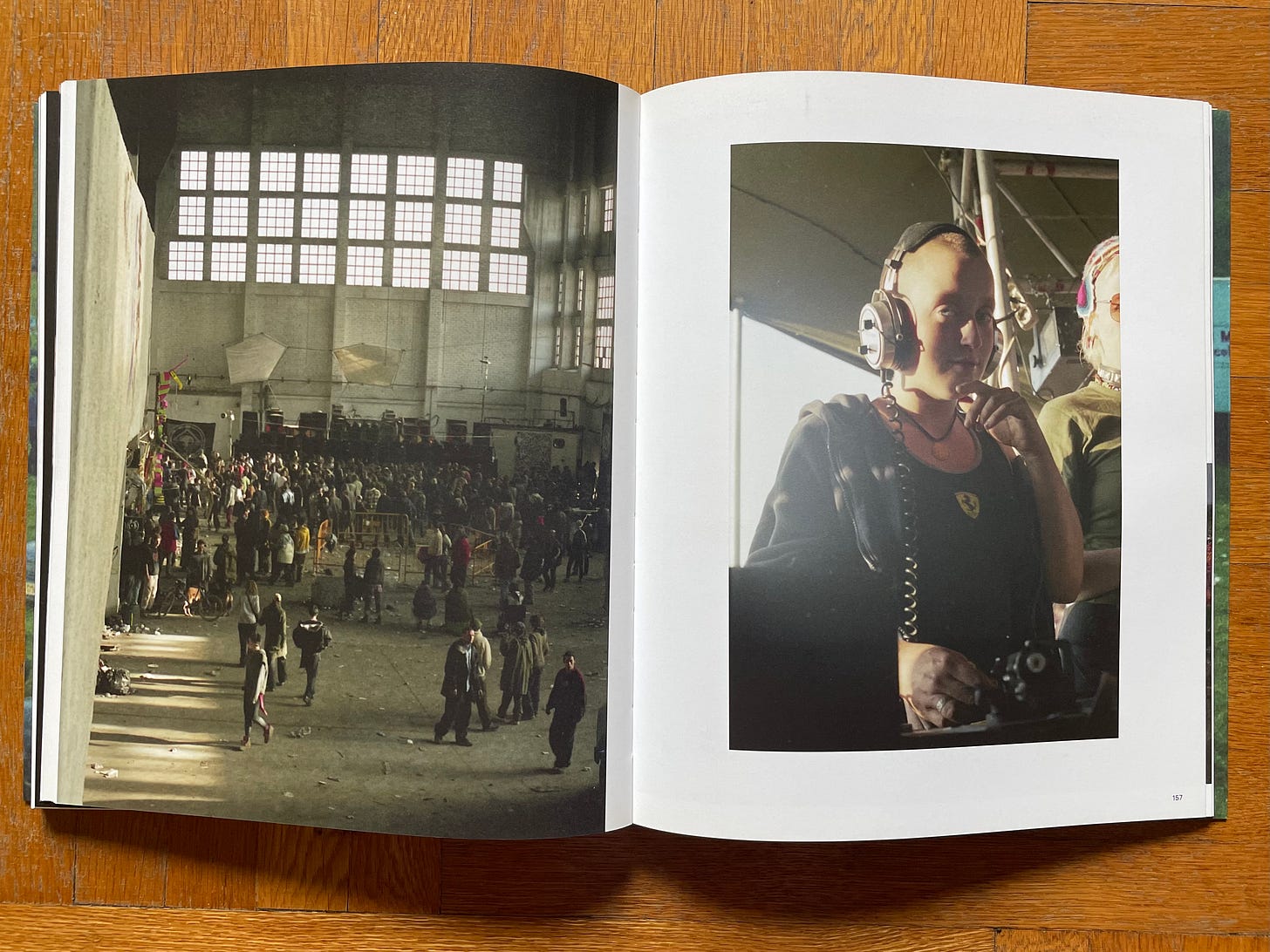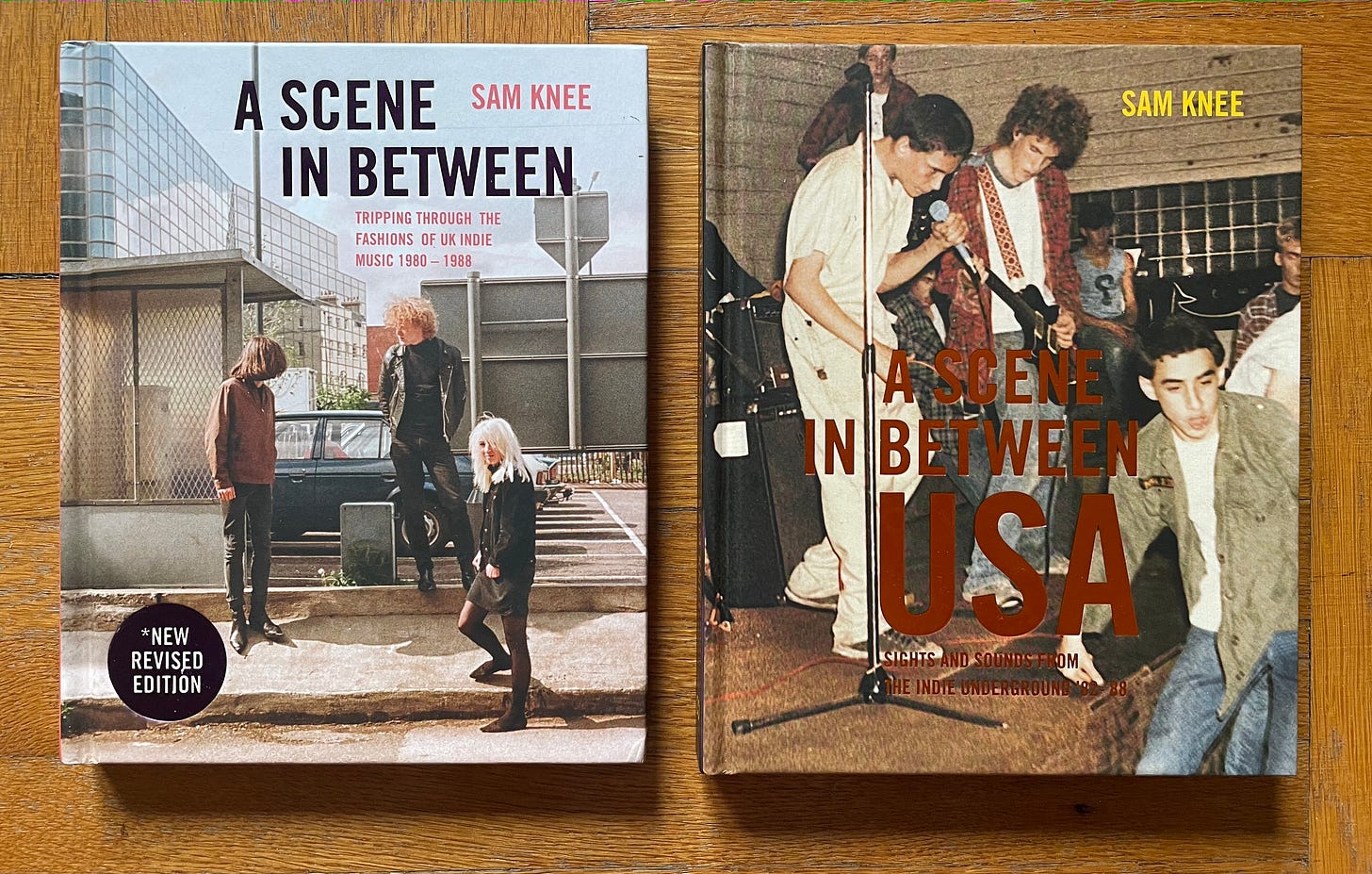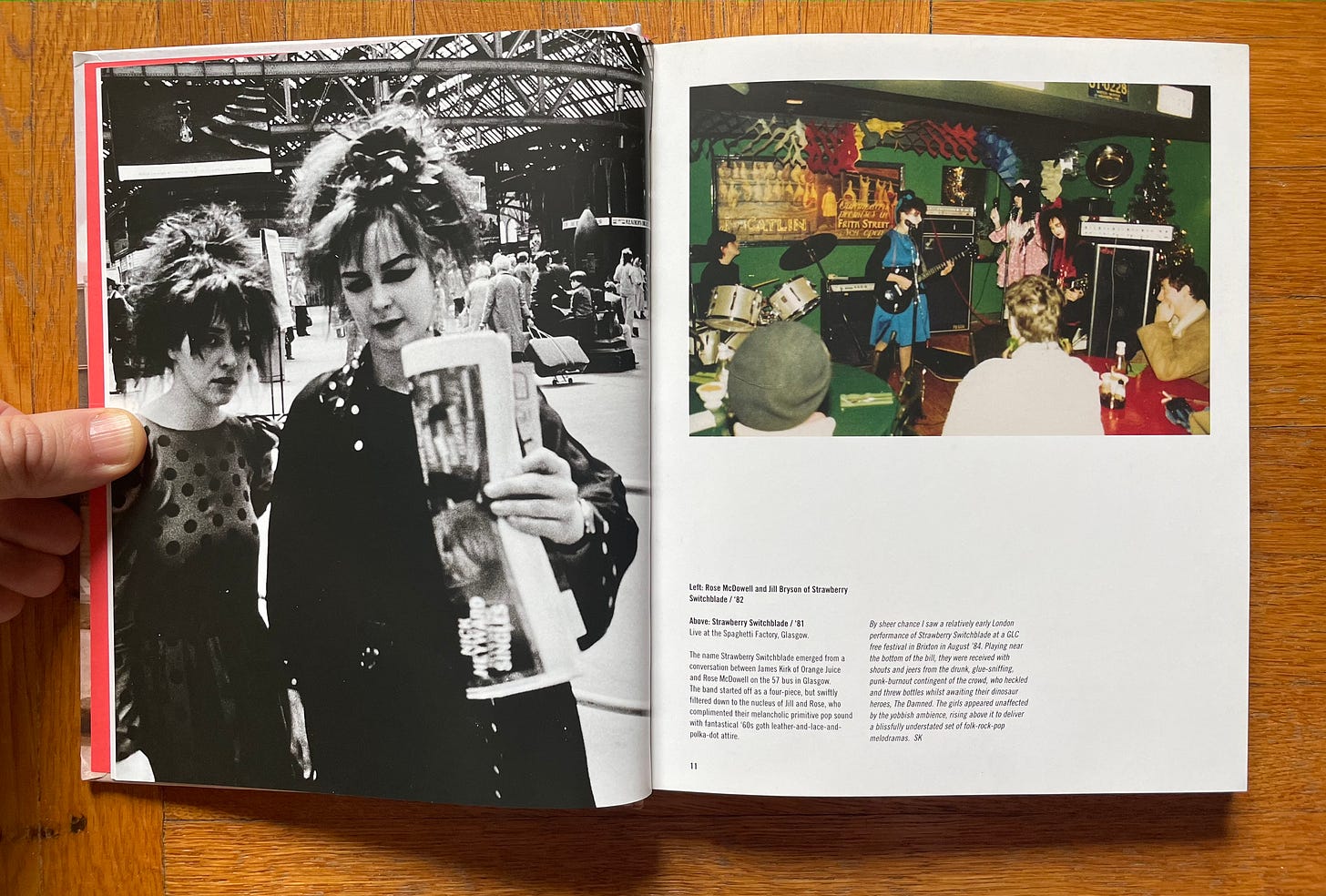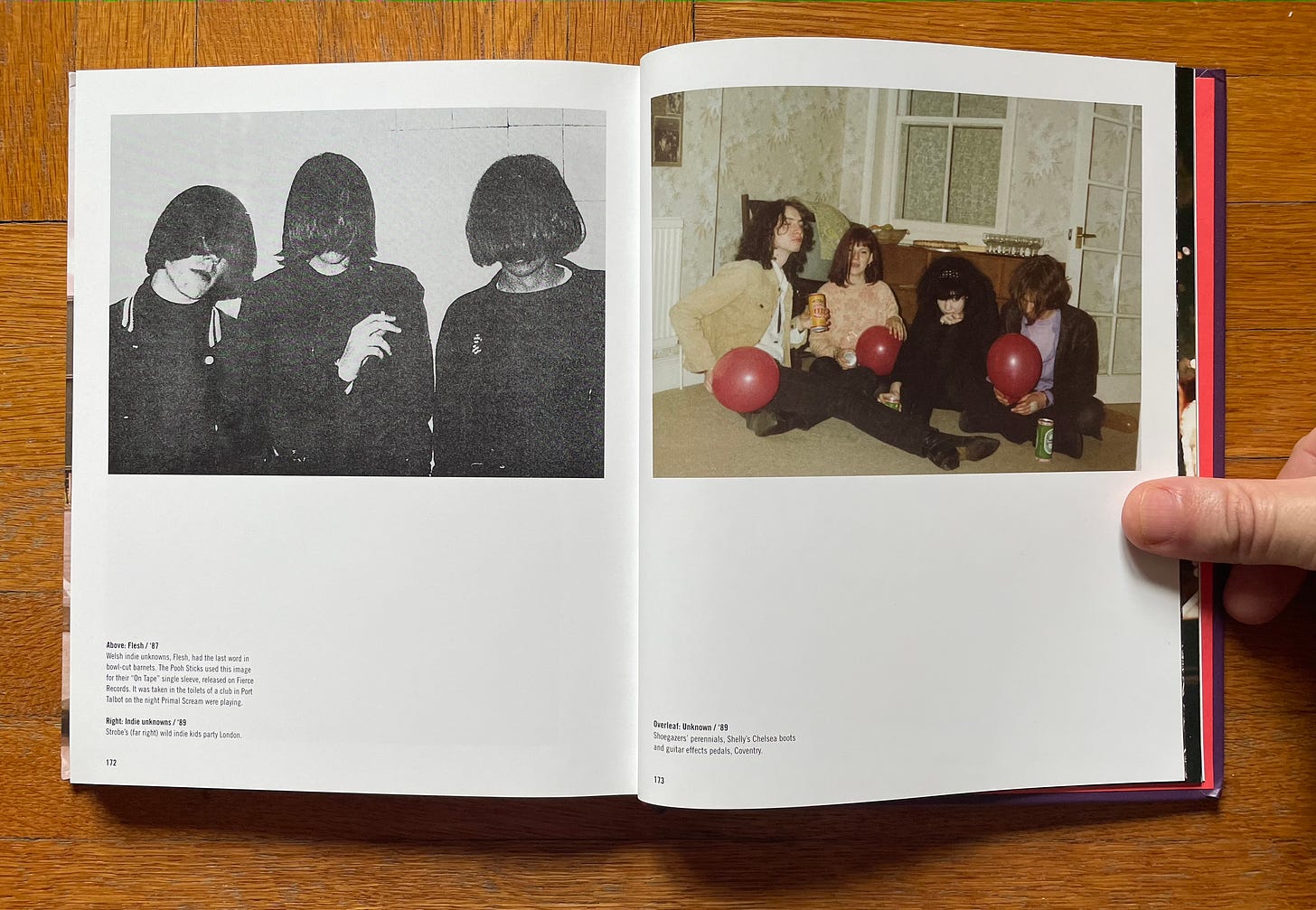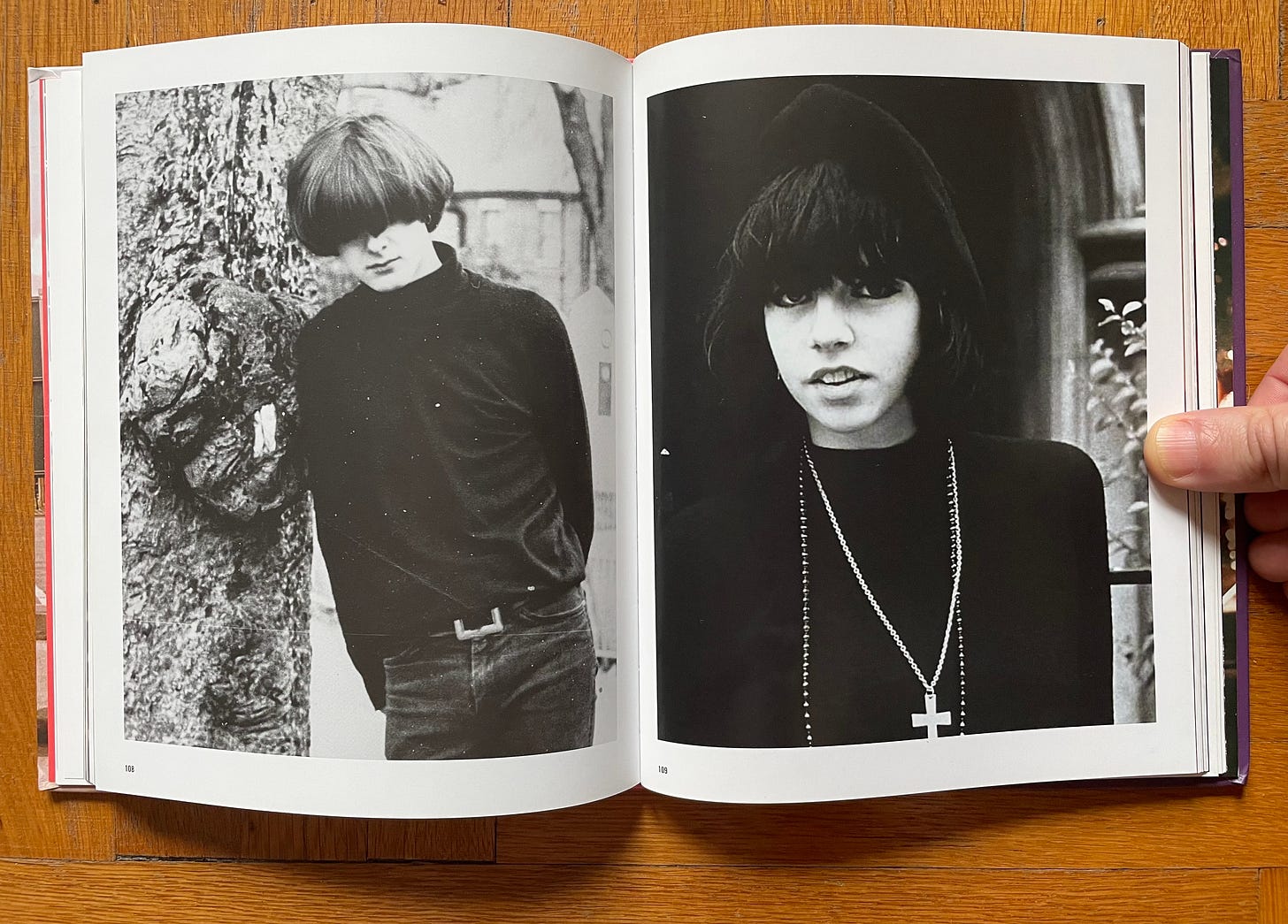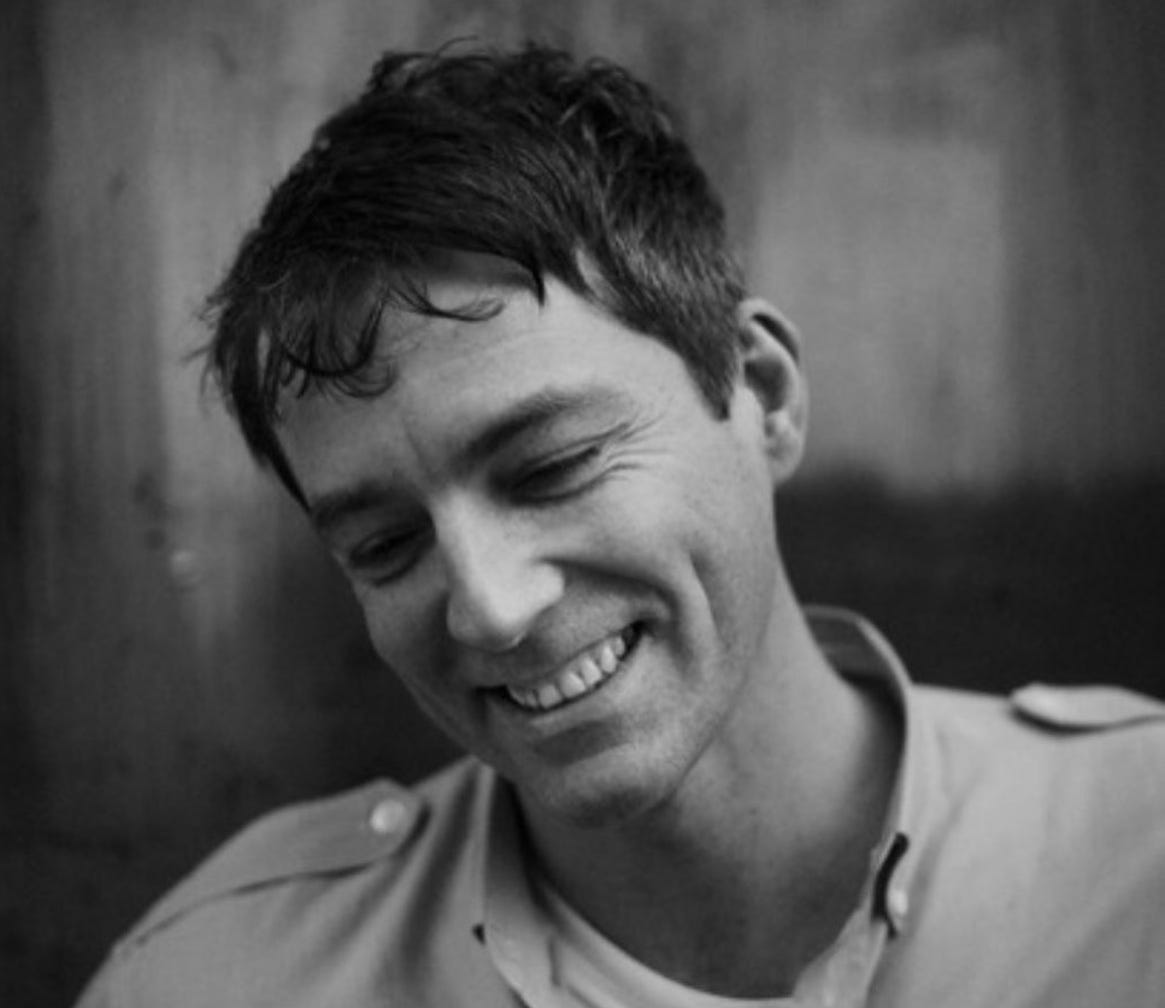Issue 23: Scenes In Between
You had to be there. Plus: Steve Mackey remembered
Photography books about music culture seem to be everywhere these days. Large-format hardbacks of sumptuous black-and-whites capturing sweaty ravers at the Shoom club in 1988. Oversize publications with gorgeous wraparound dust-jackets depicting the ways Shibuya-kei kids dressed in 1990s Tokyo. Here, nostalgia meets anthropology. The books are hybrids of performance and street photography; shots of bands on stage and fans in the crowd, catalogues of haircuts and shoe styles. You can find them on the display tables of a certain kind of specialist bookshop—the ones that also sell third edition Kathy Acker novels and dog-eared back issues of Interview for the price of a pedigreed puppy—and in menswear stores placed next to a single pair of $200 Argyle socks. “You saw Nirvana play in 1990? Amazing. You must try on these tobacco-suede tasseled loafers from Italy.”
The proliferation of these books is relatively recent, a marker of 21st century nostalgia culture and its hyperbolic assertions of ‘classic’ this and ‘vintage’ that. But as a photo genre it’s as old as pop music itself. Images of mid-century jazz and rock musicians could probably fill the Mariana Trench. Among my favourites are Karlheinz Weinberger’s wild, erotic photos from the 1950s of teenage rebels in Switzerland (see above). At art college I owned a photo book about mods in 1970s Britain, which I loved, lost and subsequently forgot the title of: if any readers out there can suggest to me what it might have been, I’d be grateful. Hip-hop and punk books are hardy perennials. Back in the Days, Jamel Shabazz’s chronicle of the early New York hip-hop scene, published two decades ago, is an eye-popping and essential collection. (The first run of the book apparently sold 35,000 copies.) Sheila Rock’s Young Punks from 2020—front-line images of the 1970s London scene—is one of a seemingly endless number of punk-era photography books, most of which are far less compelling than hers. Now 1990s club culture has come into focus. There’s Dave Swindells’ Acid House as it Happened, for instance, or Tony Davis’ UK Rave 1991 photo-booklet for Cafe Royal Books. (Cafe Royal’s little publications are a fantastic place to find documentary photography at an affordable price.) I enjoyed Seana Gavin’s Spiralled (2020), a fascinating and raw account of her life travelling across Europe with renegade free party soundsystems.
At best, these publications have sociological value. They’re records of fashion, demographics and behaviour, capturing the energy and anxiety that can surround an emerging youth subculture. At worst they’re repetitive and nutrition-free. Double-page spreads of graffiti-covered basement clubs you never attended, of sweaty, gurning people you don’t know and whose mythologization you fear you’ll never hear the end of. Other people’s hedonism is boring in the same way that at a stranger’s holiday photographs are. (Art world photo books, a real niche genre, slide along a similar full-to-empty scale of historical value. Johnnie Shand Kydd’s fly-on-the-wall book about the Young British Artists, Spit Fire, from 1997 is interesting up to a point, but photos of artists boozing get tired quickly. Ugo Mulas’s New York: The New Art Scene, from 1967, is good for candid portraits of artists at work in cold, grotty lofts. One of my favourites is Snowdon’s 1965 Private View—genteel subtitle, The Lively World of British Art—which collects striking colour images of artists in Swinging London. It’s recommended if, like me, you enjoy looking at photos of a young David Hockney’s outfits.)
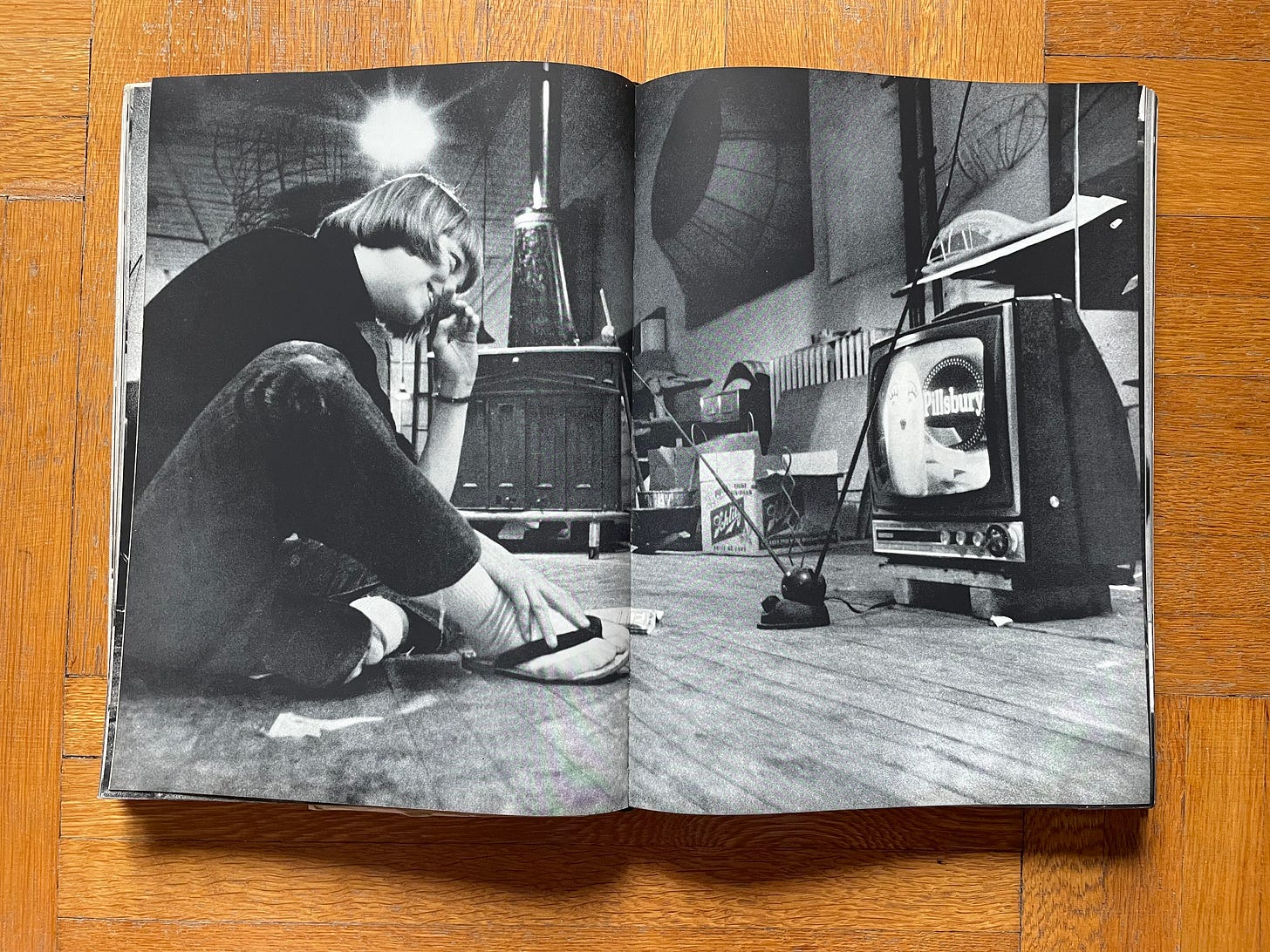
Two titles by Sam Knee take a different tack. A Scene In Between: Tripping Through the Fashions of UK Indie Music 1980–1988 (published in 2013, reissued last year), and its sequel A Scene In Between USA (released at the end of 2022) cover a period of the 1980s that falls between the tail-end of punk and the paradigm shifts of rave and grunge. These publications are modest and appealing, little bigger than paperback novels, avoiding a trap that huge art books can fall into of over-inflating the importance of their subject. The images in them are crowdsourced from fans. These are mostly amateur snaps taken at gigs and rehearsals, awkward publicity shots made by friends. They have the soft, cheap fuzz of a point-and-shoot camera, but free of the mannerisms that developed in the 1990s when that style became a fashion photography contrivance. They’re haphazardly framed. The colour balance is off—too orange, too blue, too green—and faces are blanched by camera flash in ways that no iPhone could imitate. These photos were taken as personal souvenirs; the only way they might’ve been shared was by being Xerox’d into a local music ‘zine. Images made not in a Cartier-Bresson ‘decisive moment’ but in a rush of enthusiasm; camera in one hand, a drink pinned in the crook of an elbow, one eye on the stage, the other making sure that drunk gig-goer wobbling a few feet to your right isn’t about to tumble into you.
Knee is a writer, musician and vintage clothing expert. He runs the @sceneinbetween Instagram account, one of a number that collate photos from the 1980s indie era, including @theindependentrepository and @facingproblem. (@facingproblem is the work of Abidzan Hermawan, based in Jakarta. For the past two decades, Indonesia has been home to a music scene influenced by 1980s British alternative music.) Back then, the word ‘indie’ signalled a practical, economic independence from the music industry. It denoted alienation from mainstream music, and sheltered a wide range of guitar-oriented music styles. The term wasn’t just another synonym for mainstream rock, as it is today.
The mid-1980s was a time of rich regionalism for kids into that sort of music. In the US there were the fast and angry sounds of hardcore in Washington DC. California had the ‘paisley underground’—a jangly, melodic style influenced by their contemporaries R.E.M. in Athens, GA, and 1960s records by groups such as The Byrds. In Olympia, WA, you could find the first stirrings of grunge and riot grrl. Texas gave the world the Butthole Surfers, a group of acid-addled absurdists. In the UK, there were The Jesus and Mary Chain from Glasgow—their pop melodies lost in a blizzard of feedback—and the gentle sounds of Tallulah Gosh from Oxford and Dolly Mixture in Cambridge. Spacemen 3, from Rugby, declared that they were going to sit out the Thatcher 1980s and “take drugs to make music to take drugs to.” McCarthy, who came from Barking, wrote catchy songs about overthrowing the banking system, while Birmingham’s Felt made elegant, wistful records with titles such as ‘All the People I Like are Those That Are Dead’ and ‘Don’t Die On My Doorstep.’
Knee’s books are valuable documents of clothing styles. In A Scene In Between USA many of the looks hark back to previous decades. By-and-large they are modest and plain, oriented around workwear. You see 501s, denim jackets and plaid shirts layered over band t-shirts. (Always current groups and worn out of support, not irony or to signal hipster connoisseurship.) Sometimes these are customized with preppy items such as old varsity sweaters, sports blazers and baseball jackets. Hair is kept severe at the start of the 1980s, and grows long by its end. Almost everyone wears Converse.
In the UK at the time, it was harder find American clothing like this—Hawaiian shirts, baseball shirts and so on—and you would have to have visited a shop such as Flip, which opened at the end of the 1970s in London and specialised in American styles, or the warren of booths in Kensington Market. But second-hand clothes of other kinds, dating from the 1950s and ‘60s, were cheap and easy to find across the country. Knee points out that “Vernon Richard’s book, Protest Without Illusions, which documented the CND marches in the UK throughout the late ‘50s to early ‘60s was a key fashion influence”: corduroy blazers, chunky wool sweaters, desert boots and anoraks. And so one of the defining ‘indie’ looks that developed was part-punk, part-nerd, part-Beatnik. But there were other variations, such as sharp mod-influenced styles. On both sides of the Atlantic, a popular look was leather trousers and jackets worn with striped t-shirts, bead necklaces, and black suede Chelsea boots. Lots of polka-dot and paisley shirts, turtlenecks, bowl haircuts that covered the eyes; a suburban take on the Velvet Underground and The Byrds, copied from record sleeves and books.
The majority of books about music subcultures frame their young subjects as agents of scorched-earth modernist attitude, rebuilding the world anew. The truth is that all subcultures wrestle with the past. It’s easy to understand the 1980s indie throwbacks to the 1960s as a reaction to the glossy conservatism of that period, to Reaganomics and to free-market Thatcherism. But so too were hip-hop, goth, hair metal, or ‘80s neo-soul, and they all had vastly differing stylistic responses. The past, where it surfaced in early hip-hop, for example, was through the old jazz and funk records used in sampling. Clothing styles were fresh, not retro—in Jamel Shabazz’s photographs you don’t see anyone dressed in 1960s styles—but the clothes were worn by mostly working class youth, and, just as with the charity shop indie looks, they were sourced cheaply and the details were customized by the wearer. Similarities between subcultures, where they existed, were structural rather than aesthetic.
The kids depicted in A Scene In Between were almost all born during the 1960s. The look of that decade, its slow crossfade into the ‘70s, was baked into them, part of their formative visual experiences of the world. In the 1980s, reissue compilations of lost and obscure garage and psychedelia—the Back from the Grave series, or Lenny Kaye’s Nuggets collections—were driving an interest in guitar music of the period. TV re-runs of 1960s cartoons and shows such as The Monkees and Batman fed a general textural feel for the era. I suspect that the retro looks were more a way of dealing with something personal than opposition to the political conservatism of the time—though that too.
A few days ago, as part of MoMA’s Doc Fortnight, I saw James N. Kienitz Wilkins’ new feature Still Film. It’s a dense and funny meditation on the way cinema acts on our sense of the past, told in the form of an imaginary legal deposition about the movies. Wilkins suggests that our personal memories of films, especially of those seen in childhood, were not always created by consent. A ticket may have been bought, a TV switched on, but what we got in return was unpredictable. If it were powerful enough—scary, sad, joyous, funny—then we would find ourselves grappling with that memory for years to come.
We rarely ask for the things we become nostalgic about. “My childhood bends beside me,” wrote James Joyce in Ulysses. Then, in 1922, Joyce would have dressed the same as his father did, in a hat, suit and tie, perhaps haunted by strange dreams of a future in which he would wear black suede Chelsea boots, leather trousers and a bowl haircut.
Steve Mackey 1966—2023
My friend Steve Mackey passed away last week following an undisclosed illness. He was 56. Steve was a talented musician and producer, an accomplished fashion photographer and filmmaker, and best known as the bass player for the band Pulp.
We were introduced in 2003 by Frieze co-founders Matthew Slotover and Amanda Sharp, who were about to launch the first edition of Frieze Art Fair in London. They teamed us up to program Frieze Music, an off-site, two-day music festival to run the same weekend of the fair. I would quickly learn that I was not one of life’s natural born concert promoters, but Steve and I became friends.
We would meet in the mornings at a greasy-spoon cafe in Clerkenwell, where we’d brainstorm lists of musicians we wanted to invite to play. Conversations would drift from the job in hand to music we’d been enjoying and exhibitions and films we’d seen. He was curious about the world and his knowledge of music was deep. He loved the heaviest, the most beautiful, the funkiest, the poppiest, the most soulful, gentle or absurd music in a given genre. Anything with heart and an original voice. On one occasion, stuck for inspiration, we made a trip to the Rough Trade record shop in Notting Hill in search of something to prompt ideas. I remember how he pulled out Jah Shaka dub records, an Ennio Morricone film soundtrack, a Paul McCartney solo album, and had something insightful to say about them all. Steve was self-assured yet easy-going; he knew everyone in the store, both behind the counter and in front of it. His charm and enthusiasm were infectious.
For the inaugural Frieze Music we hired the Victory Services Club, a military veterans club next to Marble Arch. It had a ballroom with a sprung floor, and a large mural on the back wall of the stage depicting fighter jets flying over a pair of Chelsea Pensioners. Steve seemed to have a mischievous streak—I remember his frequent use of the word ‘wrong’ as a term of approval—and he believed Victory Services would be the perfect ‘wrong’ venue because it was so at odds with the music we wanted to put on. For one of the shows we invited the conceptual artist Rodney Graham to play an acoustic set of his funny and bittersweet songs. I remember the look on Rodney’s face when he arrived and Steve told him he had a backstage dressing room and a food and drink rider. Rodney seemed tickled to be treated as a professional musician would be. Steve put tables out in the ballroom, each lit with candles, and invited Bob Stanley and Peter Paphides to DJ old British folk records as the audience assembled. The atmosphere was electric.
In 2006, Steve and I teamed up with the promoters Upset the Rhythm to put on a concert by Sunn0))). We somehow managed to rent two nights at the Hippodrome in London’s West End, a Victorian water circus turned music hall turned sleazy nightclub with an illuminated dancefloor. It was just the right ‘wrong’ venue for Sunn0))), who performed wearing monk’s cowls and had a reputation as the loudest, heaviest metal band on the planet. The night was dramatic to say the least. Too many incidents to list here, but it involved the police, multiple artist tantrums, furious fans stuck outside (the venue had ‘misinformed’ us about the capacity so Steve started sneaking people in through the stage door), thousands of pounds in cash stuffed in a rucksack I had to carry around all night, a fog of purple dry ice so thick that you could not see your hand in front of your face and music so loud that it shook the bar to pieces and sent the owner screaming blue murder at us for “undermining the structural integrity” of the Hippodrome. The event had a sense of excitement and danger to it that Steve loved. At the end of the performance, as I sat shell-shocked on the edge of the stage, he emerged through the dry ice, grinning from ear-to-ear. “What an hilarious night!”
Steve and I stayed in touch after we finished working together on Frieze Music. I wouldn’t hear from him for a year or two, then he’d phone out of the blue to enthuse about something new. It might simply be a music documentary he’d seen, or wanting to share his excitement about ‘Call This Number,’ the series of pirate TV-style music videos he made with Douglas Hart and Jeanette Lee. Steve frequently worked in fashion, often in collaboration with his wife, the stylist Katie Grand: once he called to tell me that he was directing the music for a Gucci show, which had led him to wonder if I could recommend to him some good avant-garde organ music. I loved the specificity of his question. Whatever he was enthusing about, his refrain would always be the same: “Seriously Dan, you’re gonna love this.”
In an Instagram post the day Steve died, Jarvis Cocker wrote that “Steve made things happen.” It’s true. I admired his energy and Steve’s early departure has left me with a sense of urgency. Make the most of your time here, it will disappear faster than you think.
RECOMMENDATIONS
I have just one recommendation this week: a song by Lonnie Holley from his new album Oh Me Oh My.

